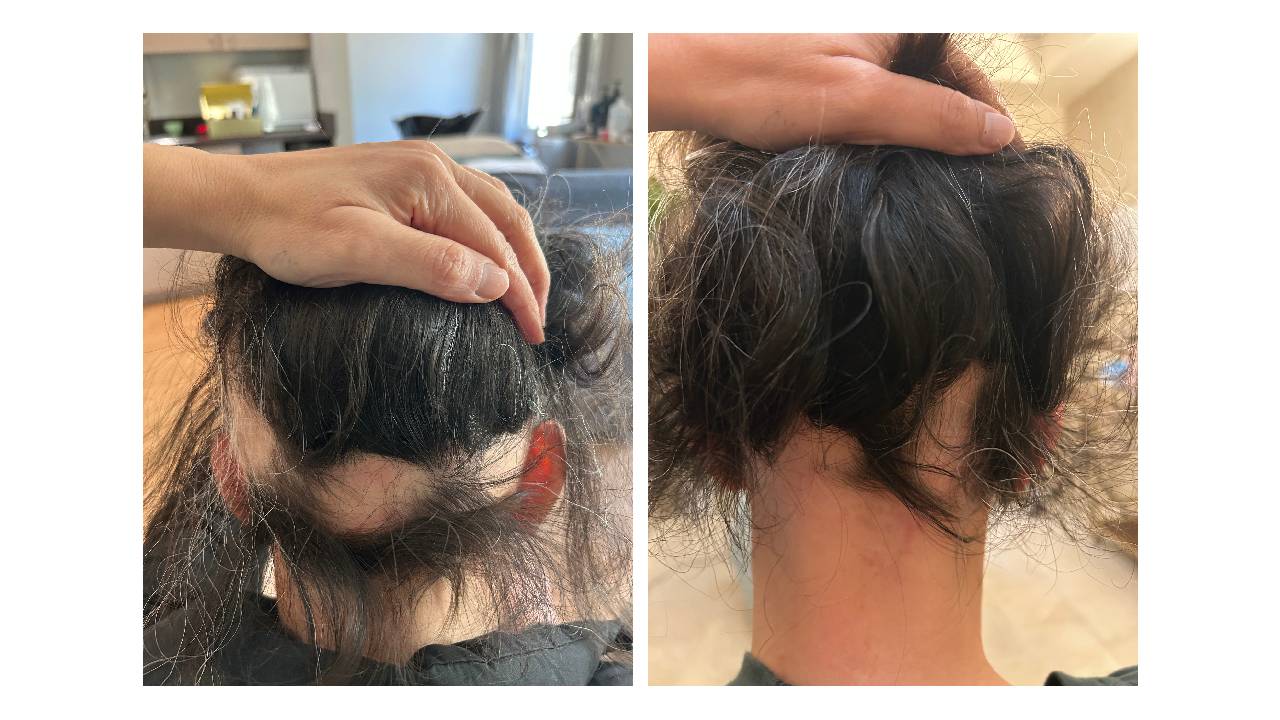
Abstract
Alopecia areata (AA) is an autoimmune condition characterized by non-scarring hair loss. The ophiasis variant, which affects the occipital and temporal regions of the scalp, is often resistant to conventional therapies and associated with a poorer prognosis. This case study presents a client with alopecia areata and ophiasis whose condition was linked to recurrent fungal infections, high systemic toxicity, and compromised immune function. A functional trichology approach integrating gastrointestinal analysis, functional blood chemistry assessment, and targeted scalp therapies was employed. After eight months of treatment, the client demonstrated near-complete regrowth in the top, sides, and crown-adjacent regions, with ongoing management of residual activity in the occipital ophiasis band.
Introduction
Alopecia areata is an autoimmune disorder in which the immune system targets hair follicle structures, resulting in unpredictable patterns of hair loss. Ophiasis, a less common but clinically significant variant, manifests as a serpentine band of hair loss along the occipital and temporal scalp margins. This presentation is often more resistant to therapy and associated with chronic disease activity (Messenger & McKillop, 2019).
Conventional management strategies frequently focus on immunosuppression. However, an integrative trichological perspective recognizes alopecia as an expression of systemic imbalance, where immune dysregulation, microbial overgrowth, impaired detoxification, and nutrient deficiencies converge (Gilhar et al., 2019). This case illustrates the application of functional medicine modalities through a trichological lens to address both systemic and scalp-related drivers of hair loss.
Case Presentation
A female client presented with alopecia areata progressing into ophiasis. The condition had persisted despite conventional approaches, with hair loss most pronounced in the occipital region. The history revealed recurrent fungal scalp infections and symptoms of systemic imbalance, including digestive disturbance, low energy, and signs of inflammatory stress.
Gastrointestinal Findings
Comprehensive stool analysis identified multiple disruptions in gut ecology. Dysbiosis was evident, with an unfavorable ratio of beneficial to pathogenic organisms, impairing nutrient assimilation. Increased intestinal permeability suggested compromised barrier function, allowing endotoxins to enter systemic circulation and aggravate immune activity. The presence of Helicobacter pylori further compromised gastric acid production, limiting protein breakdown and micronutrient absorption. Pathogenic overgrowth, including fungal organisms, aligned with the client’s recurrent scalp infections. Collectively, these findings pointed to a disrupted gut–immune–hair axis.
Functional Blood Chemistry
Functional blood chemistry analysis was employed to identify early metabolic imbalances and optimize the internal environment for follicular health. Unlike conventional laboratory interpretation, which relies on broad population ranges, this method applies narrower functional ranges that better reflect optimal physiological states relevant to hair regrowth.
Key observations included elevated vitamin B12, suggestive of poor cellular absorption despite adequate intake, and high LDL cholesterol, raising concern for reduced scalp microcirculation. The albumin/globulin ratio and elevated red blood cell count indicated inflammatory stress and dehydration. Sodium was above optimal range, reflecting adrenal strain. Markers of immune activation, including elevated basophils and eosinophils, pointed to ongoing inflammatory or allergic triggers. Vitamin D and ferritin were below optimal levels, both critical nutrients for follicular cycling and immune modulation (Ramos et al., 2020).
These findings reinforced the presence of systemic stressors undermining the client’s ability to maintain immune tolerance and hair follicle integrity. From a trichological perspective, the objective was to optimize nutrient status, reduce inflammation, and restore balance to support regrowth.
Intervention
The management plan integrated personalized internal and external protocols.
Internally, a phased functional medicine program was implemented to:
Repair gut integrity, reduce dysbiosis, and control fungal overgrowth.
Support liver function and detoxification pathways to reduce toxic burden.
Correct deficiencies and restore optimal nutrient levels essential for hair growth.
Build immune resilience through dietary and lifestyle modifications, including moderate exercise and stress management.
Externally, scalp-directed therapies complemented internal work. Scalp detoxification and pH balancing were prioritized to reset the local environment. Ozone therapy and high-frequency treatments were employed to suppress microbial overgrowth, while microneedling and laser stimulation were used to reactivate follicular activity.
Together, these strategies sought to both remove barriers to regrowth and create the systemic conditions necessary for hair recovery.
Outcomes
After eight months of treatment, the client exhibited significant improvement. Full regrowth was achieved in the top, sides, and crown-adjacent scalp. Recurrent fungal infections were eradicated, and scalp imaging confirmed the absence of active alopecia areata lesions in most regions. The ophiasis band in the occipital scalp remained the most resistant, though activity had decreased in intensity and surface area.
The client’s systemic markers showed improvement, with reductions in inflammatory signs and stabilization of nutrient levels. Subjectively, the client reported improved energy, digestive health, and reduced scalp sensitivity. While the occipital ophiasis area remained under active management, the overall trajectory indicated sustained remission in most affected zones.
Discussion
This case highlights the complexity of alopecia areata and ophiasis and the value of addressing root causes through a functional trichology framework. Several key points emerge:
Gut–Immune–Hair Axis: Dysbiosis, leaky gut, and H. pylori presence disrupted immune tolerance and nutrient assimilation, amplifying autoimmune reactivity (Kumar et al., 2021).
Detoxification and Toxic Load: Liver stress and systemic toxicity likely contributed to chronic inflammation and immune burden, underscoring the importance of detoxification pathways.
Nutrient Optimization: Suboptimal vitamin D and ferritin were corrected with the goal of supporting follicular cycling and immune balance.
Scalp Microenvironment: Recurrent fungal infections contributed to local immune activation and required targeted antifungal and biofilm-disrupting approaches.
Trichological Perspective: By using functional blood chemistry through a trichological lens, subtle imbalances were identified and addressed before they escalated into overt disease, optimizing conditions for hair regrowth.
The persistence of activity in the ophiasis region reflects the known chronicity and resistance of this variant. However, the overall outcome demonstrates that systemic and scalp-focused integrative care can reverse extensive alopecia areata and stabilize progression.
Conclusion
Alopecia ophiasis presents a considerable therapeutic challenge. This case study demonstrates that an integrative trichological approach, combining functional medicine modalities with targeted scalp therapies, can lead to substantial regrowth even in resistant cases. By restoring gut health, supporting detoxification, optimizing nutrient status, and controlling microbial triggers, near-complete remission was achieved within eight months. Continued immune system strengthening remains essential for achieving full recovery in the occipital region.
References
Bergfeld, W. F., & Mulinari-Brenner, F. (2020). Alopecia areata: Clinical presentation, diagnosis, and unusual cases. Dermatologic Clinics, 38(3), 223–228. https://doi.org/10.1016/j.det.2020.02.004
Gilhar, A., Etzioni, A., & Paus, R. (2019). Alopecia areata. The New England Journal of Medicine, 380(1), 60–70. https://doi.org/10.1056/NEJMra1612602
Kumar, N., Pathak, R., & Hajam, Y. A. (2021). Gut microbiota and autoimmune diseases: Exploring the connection. Critical Reviews in Microbiology, 47(2), 238–254. https://doi.org/10.1080/1040841X.2020.1868534
Messenger, A. G., & McKillop, J. (2019). Alopecia areata variants: Ophiasis and sisaipho. Clinical and Experimental Dermatology, 44(8), 889–895. https://doi.org/10.1111/ced.14034
Ramos, P. M., Miot, H. A., & Trüeb, R. M. (2020). Role of vitamin D in hair disorders: A systematic review. Dermatology and Therapy, 10(1), 91–103. https://doi.org/10.1007/s13555-020-00347-1

